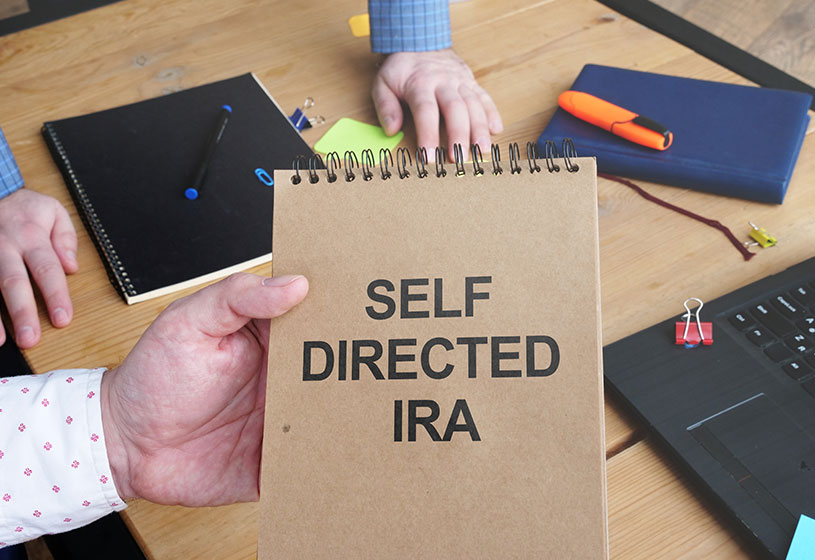Saving for retirement is an important financial objective for everyone looking to safeguard their future. While standard Individual Retirement Accounts (IRAs) and employer-sponsored 401(k) plans are popular options, some individuals prefer greater control and flexibility over their retirement assets. This is where a Self-Directed IRA (SDIRA) may help. In this article, we will look at a self-directed IRA and how it works.
Understanding a Self-Directed IRA (SDIRA)
A self-directed individual retirement account (SDIRA) is a variation of a traditional, Roth or Simplified Employer Pension (SEP) individual retirement account (IRA) that offers more flexibility in the types of investments it can hold. While regular IRAs typically limit investments to common securities like stocks, bonds, CDs, and mutual funds or ETFs, SDIRAs allow for a broader array of assets, including real estate, tax lien certificates, and other alternative investments. This means that savvy investors who seek diversification in a tax-advantaged account can benefit from SDIRAs. However, due to the complex nature of these accounts, individuals need to conduct thorough research and due diligence as they are responsible for managing and directing the assets themselves.
How to Open a Self-Directed IRA (SDIRA)
Unlike traditional brokerages and investment companies that typically offer regular IRAs, Self-Directed IRAs are generally available through specialized firms that provide SDIRA custodian services. When opening a SDIRA, individuals must find qualified IRA personnel specializing in self-directed accounts like Nevada Trust Company®. Individuals can set up the SDIRA account then contribute or transfer money to it, just like any other IRA. However, it’s important to note that custodians cannot provide financial advice for SDIRAs, so investors should be prepared to manage their investments independently. Seeking assistance from a financial advisor experienced in managing self-directed IRA investments is recommended for those who require guidance.
Taxes, Withdrawals, and Contributions for SDIRAs
Contributions to Self-Directed IRAs are subject to annual limits, with $6,500 for individuals under age 50 and an additional $1,000 catch-up contribution allowed for those over 50 in 2023. When making withdrawals from an SDIRA before the age of 59½, regular income taxes based on the account holder’s income level apply, along with a 10% penalty on the withdrawal amount. The IRS requires individuals to start taking withdrawals from their SDIRA when they reach the age of 73, and the amount withdrawn must meet minimum requirements based on the account balance and life expectancy. Please see IRS Publications 590 A & B for the current IRS rules.
Risks and Considerations
While self-directed IRAs offer greater investment flexibility, they also come with additional risks and considerations. Individuals should be aware of potential fees (what is there besides our fee?) associated with SDIRAs, as well as the possibility of encountering fraud or fraudulent investment schemes. The complexity of managing alternative investments in a SDIRA calls for greater initiative and due diligence by the account owner. Additionally, certain types of investments, such as collectibles and life insurance, are still prohibited by the IRS for Self-Directed IRAs. Understanding these risks and being prepared to conduct thorough research is essential for investors considering SDIRAs (please reference IRS Publications 590 A & B for the current IRS rules).
The Bottom Line on Self-Directed IRAs
Self-directed IRAs offer the advantage of allowing investors to have control over how their retirement funds are invested. Unlike traditional IRAs, these accounts require active monitoring and management to ensure they perform according to your preferences.
While SDIRAs can be a great option for experienced investors with extensive knowledge of the financial markets, they might be too complex for a novice or intermediate retail investor. Owning an SDIRA is akin to managing your retirement fund, which demands a higher level of understanding and involvement.
How to Fund your SDIRA
The process is quick and simple. First complete Nevada Trust Company®’s new account packet. Then, you are ready to fund the account with either a contribution or transfer from another IRA custodian. Once your account is funded, you are ready to start purchasing assets like real estate, life (insurance) settlements, precious metals and more. Contact us today for a new account application and we can walk you through the process.






